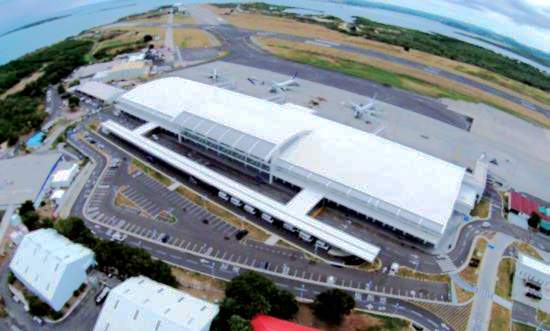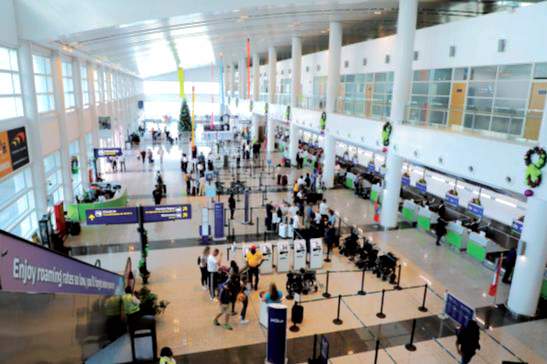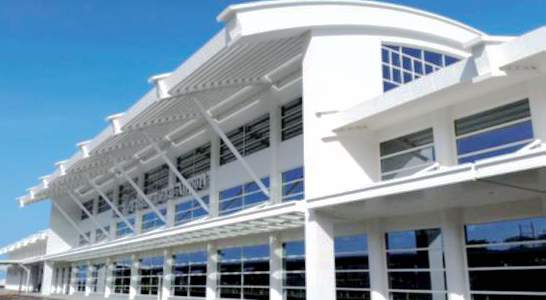New Gateway to Antigua and Barbuda
by Li Cunnan
[Antigua and Barbuda] H.E. Brian Stuart-Young
As the plane hovered in the sky in preparation for landing, Peter looked down from his porthole. In the blue Caribbean Sea below, he could make out twin dots, the two small islands of the state of Antigua and Barbuda lying close to each other.

This was a revisit for him, an avid diver. On his graduation trip, Peter had stayed in a diving resort in Antigua and Barbuda with his friends and the beautiful scenery had left a deep impression on him. Now he was back, bringing his family with him to re-savor its beauty.However, when he got off the plane and reached the passenger terminal, he stopped in his tracks in amazement.
This was not the old terminal where he had been in the past. This was a magnificent new terminal sprawling over more than 20,000 sq m. Sleekly designed, it had a curved roof in line with the local architecture and a row of lofty columns. A signboard caught his eye and he walked over and read it with interest. It said the new terminal building of the V.C. Bird International Airport was financed by the government of China and constructed by China Civil Engineering Construction Corporation (CCECC). It was officially opened on August 20, 2015.

A panoramic view of the new terminal of the V.C. Bird International Airport
New Flight Experience
Antigua and Barbuda has many scenic beaches, beautiful scenery and a tropical climate. Tourism is the main industry here, with tourism and related industries accounting for more than 70 percent of the GDP. Antigua especially is famous for its beaches, international rowing races and carnivals, while Barbuda attracts a lot of tourists thanks to its frigate birds and pink sand beaches. It is one of the Caribbean countries with the highest dependence on tourism.
Successive governments sought to build the country into an aviation hub in the Eastern Caribbean to promote tourism and related service industries. However, the old airport terminal was small with outdated equipment and the continuous growth in the number of tourists made it increasingly overburdened. A new terminal became an urgent necessity.
At the request of the government, the Chinese government financed a new terminal – an 18.5-m-high two-story building with a construction area of more than 50,000 sq m.
As the new terminal was to be built adjacent to the old one, during the construction, the builders needed to ensure that the old terminal would function normally. This meant following high standards for the separation of the two buildings, safety measures and security. To meet the requirements, the contractor made strict specifications and construction was carried out after fully enclosing the construction area. Regular safety training was held for all employees, and the safety measures in the construction area were constantly monitored. In this way, the construction team was able to ensure smooth progress and construction safety of the new terminal while not disturbing the operation of the old one.
During the work, the Chinese contractor also overcame difficulties in the construction of the main structure and in the installation and joint commissioning of the airport's special electromechanical systems. The engineering design, construction, supervision and acceptance inspection all ensured a quality project.
The Chinese contractor also gave great importance to making the project environment-friendly. The building utilizes natural light, solar energy and rainwater. It uses low-emissivity glass to minimize the amount of ultraviolet and infrared light coming through,double-layer roof panels, spherical air vents and energy-saving materials. The terminal has eight energy-saving systems to maximize resource conservation and reduce negative impacts on the environment. It was designed and constructed in accordance with modern 4E standards for airports and can meet the operational requirements of handling 1.5 million passengers per year.
With the joint efforts of the builders of the two countries, the new terminal was smoothly handed over on August 20, 2015, and trial operation began that day.
The airport is Antigua and Barbuda's gateway to the rest of the world. The new terminal has greatly enhanced the international passenger reception capacity of the country, consolidated its status as a transportation hub in the Caribbean, and become a landmark the people are proud of. Prime Minister Gaston Browne said, "China's assistance has brought brighter prospects to Antigua and Barbuda and the entire Caribbean region."
In its over four years of operation, the new terminal has boosted economic development in Antigua and Barbuda. In 2018, the number of tourists visiting the country exceeded 1 million, and the number of overnight visitors increased significantly.
A Modern Airport
Today, the V.C. Bird International Airport is one of the most advanced airports in the entire Eastern Caribbean. The highly automated terminal is equipped with a security check information system, an information integration system, a computer network system and an automatic baggage sorting system.
Efficient management and a comfortable travel experience have earned the airport a stellar reputation and more and more passengers are choosing it as a transit airport. The number of flights to the UK increased from five to 14 per week, and the number of daily flights to the United States increased to two on weekdays and four on weekends.

Inside the modern new terminal
The modern information management system has greatly improved the operational efficiency of the airport. In terms of safety and security, the airport has reached advanced international levels, ensuring passengers' convenience and comfort and winning praise. It promotes the image of Antigua and Barbuda and the development of its tourism sector.
Martin, a ground crew member of LIAT (Leeward Islands Airport Transport) airline, is a baggage sorter and handler at the airport. Every day, his work means having to bend down a lot and carry a large amount of baggage. "In the past, we had to pick up our passengers' luggage from a common luggage carousel shared with other airlines. We had to keep on bending down and straightening up. We usually got backaches after a day's work and sometimes we made mistakes," he said. "But now the problem has been taken care of."
There are three automated luggage carousels in the new terminal which sort out the luggage of different airlines automatically. "I just need to work at the carousel assigned to our company," Martin said. "Although the number of flights and passengers has increased, my work is much easier than before. My back pain has also lessened."
Creating Local Experts
Getting a job at the V.C. Bird Airport is the dream of many locals. From the beginning of the construction of the new terminal, the Chinese team gave great importance to training local employees. It also used a lot of local construction machinery and equipment, strengthened cooperation with local construction-related industries, and employed 350 locals. After the new terminal opened, more than 500 local jobs were created.
Tymon is responsible for the maintenance of all the mechanical equipment at the terminal. The airport has many electromechanical systems manufactured in different countries or regions such as the United States, Europe and China. Their power supply system, interface parameters, and installation methods are different and connectivity and joint operation is difficult.
To master the techniques as soon as possible, whenever professional equipment was installed during the construction, Tymon would come to the site early. He not only took part in the work but also asked the Chinese engineers and manufacturers questions to learn how to run them. Everyone jokingly called him an "excellent student".

The facade of the new terminal
Tymon was fine with it. He said there is so much high-tech equipment in the terminal that he mustn't miss such good opportunities for learning about them. "Today, our Chinese friends are here helping us to construct and install them, but in the future, we will have to maintain them ourselves," he said. "I want to learn the skills and operate our own terminal."
Tymon became a fixture at the installation, commissioning and training sites of the baggage sorting system, the online security check machine, the boarding bridges, elevators, escalators, generators and other equipment. He worked and took assiduous notes. In case he forgot some of these instructions, he also videotaped the processes with his mobile phone for future reference.
His diligence has paid off. After the terminal opened to traffic, he became the backbone of the technical team, and now he is the head of the mechanical repair team that ensures normal operation of the terminal. "We thank China and our Chinese friends," he said. "They built such a good terminal and passed on expertise to us so generously. They are our true friends."
Long distances cannot separate true friends. The coat of arms of Antigua and Barbuda features a shield at the center. Below it is a scroll with the national motto: "Each Endeavoring, All Achieving". The construction of the new terminal reflects this motto. The new terminal has made travel more convenient and shortened distances. The joint efforts of builders from China and Antigua and Barbuda have brought the two nations closer in affectionate friendship.
FOR MORE
Project Overview:
The new terminal of the V.C. Bird International Airport of Antigua and Barbuda was contracted by China Civil Engineering Construction Corporation as an engineering, procurement and construction project, with the Chinese government providing financial support.
The total construction area of the project is 53,830.81 sq m. The terminal was officially delivered and began trial operation on August 20, 2015. It is hailed as one of Antigua and Barbuda's most majestic infrastructures. After the terminal opened, it was named "Airport of the Year in the Caribbean 2015" by a travel magazine focusing on the Caribbean region.


